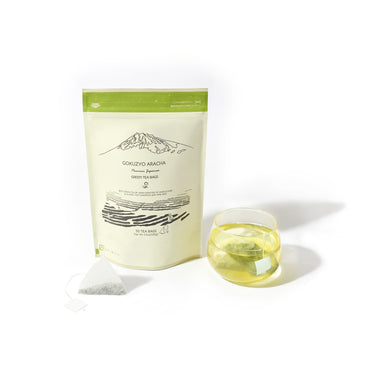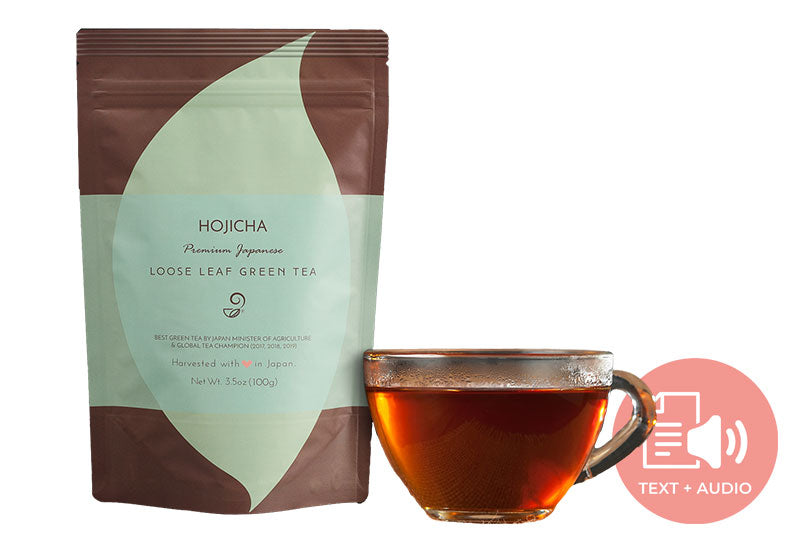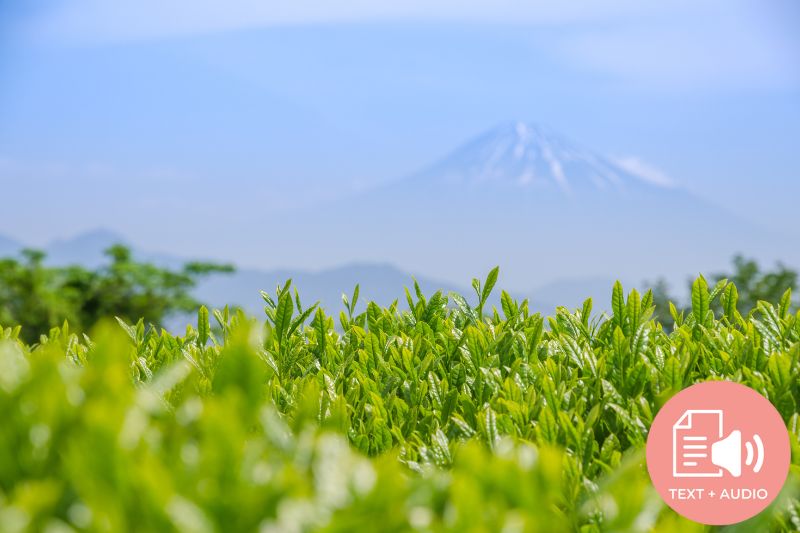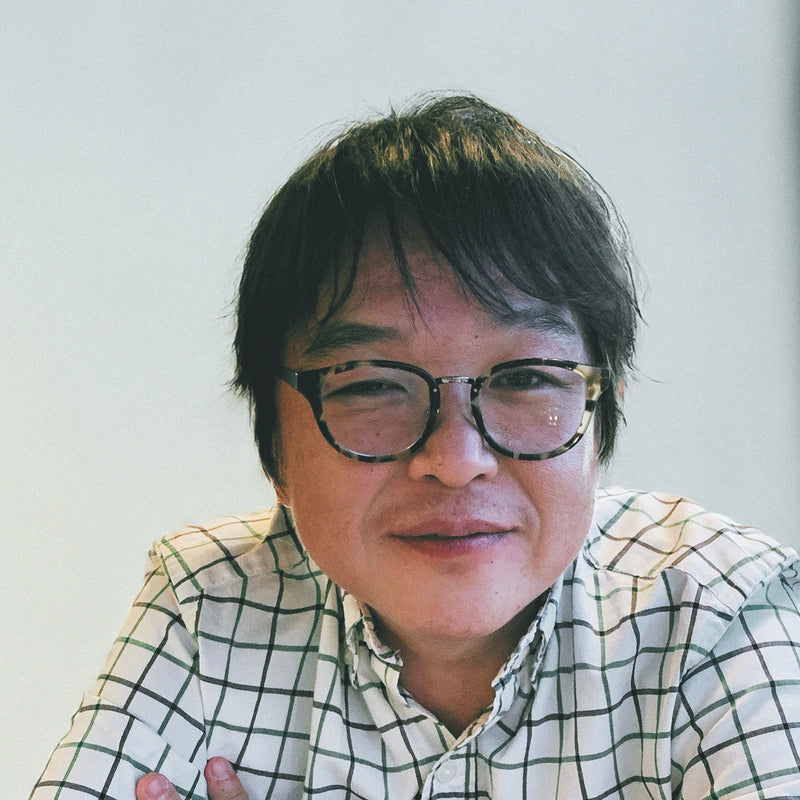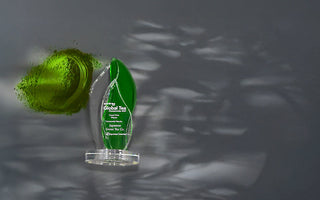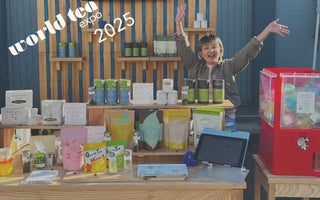What is Aracha?
Also called “farmer’s tea”, “raw tea”, or just unrefined tea, Aracha is the base tea for the tea we drink everyday. It has a bold, but sweet grassy taste, with a infusion of deep green colour.
It is the result of the first tea processing stage: steaming, rolling and drying. Ara in Japanese means crude, rough, or raw, while cha is the Japanese translation for tea; hence, translated as "raw tea". Aracha encompasses all parts of the leaf - the stems, veins, baby hairs and bits of broken down leaf.
Processing is usually carried out by farmers themselves, or in shared local factories. The first step in the processing, as mentioned above, is steaming. This is carried out to prevent the freshly picked tea leaves from oxidizing, or in other words, to prevent it from turning brown. The purpose of this first step is to preserve the quality in flavor and aroma that is specific to green tea. After this is done, the leaves are rolled and dried by farmers themselves, or in shared local factories.
Aracha is made from Camellia Sinensis, where Sancha and Matcha, the most popular green teas are also made from.

Where Can We Find Aracha?
Although Aracha is ready-to-drink as-is by following the brewing instructions provided, since it is usually sold to brokers first then to different tea companies and distributors to be processed, Aracha itself is usually not directly distributed to consumers. However, they do make its way through to local tea shops for the fans who enjoy its rich and natural taste and flavor!
Processing of Aracha Tea
Fresh tea leaves are first processed into Aracha first; therefore, Aracha is actually the first step in every green tea production. The leaves are steamed while they are still fresh, in which the enzymes are inactivated during the process. Finally, the leaves are pressed and heated through a series of treatments, including primary rolling, rolling, secondary rolling, and final rolling before they are dried to be produced as needle-shaped tea leaves.

More Detail About Aracha Processing
The process of making crude tea is divided into 6 sub-processes. As it was just mentioned above, steaming is the first step, and the process usually lasts for about 30 seconds to 2 minutes to kill the oxidizing enzymes in the fresh leaves. However, this also adds fragrance to the smell and increase the flexibility of the leaves, which helps the operation of the making process to be easier and smoother. After the leaves are steamed evenly, they are cooled down rapidly.
Primary Drying and Rolling are done by twisting and drying the leaves in a machine with press arms and stir arms that hold the temperature of about 35 centigrade. The drying process lasts for about 45 minutes, and it helps the leaves to dry off effectively; giving the leaves higher quality as a result of. The next step, rolling, consists of twisting the leaves and pressing them without heat. This allows the leaves to have uniform moisture, and usually takes about 20 minutes.
A direct-fired furnace carries out the Secondary Drying and Rolling, in which the main shaft with press arms in a rotary drum presses and dries the leaves, gradually giving them a longer shape. This process takes about 40 minutes, and the final drying and rolling is then done to reduce the leaves` moisture, after which the leaves are made to be needle-shaped by being pressed as a burner dries them. This also takes about 40 minutes to complete.
Drying of the leaves is the final process. This process consists of putting the leaves in a drying chamber heated to 80 degrees centigrade for about 30 minutes, during which the water content of the leaves is gradually reduced to about 5%.
Well, here it is – what we now have is Aracha! Farmers then distribute these leaves to several tea companies that label the final products as their own.
And now, last but not least - there is another exciting health fact for tea lovers!
During the process of manufacturing this crude green tea, chlorophyll changes to pheophytin, while the contents of glycolipids and phospholipids decrease. Without a doubt, Aracha is full of good stuff.

Health Benefits of Aracha Tea
Aracha contains more nutrients compared to other refined teas due to its "natural" state. There are four types of catechins (tannins) that produce astringent components in unprocessed tea leaves: Epicatechin, Epigallocatechin, Epicatechin gallate, and Epigallocatechin gallate. These catechnins work o reduce the absorption of fat and cholesterol, but here is a rather exciting fact - After being steam processed in the factory, four new catechins are further created!
There are so many types of Japanese green tea, but there is one thing they all have in common: most come from the tea plant, Camellia Sinensis; although there are some exceptions of Japanese green teas that are not derived from this plant.

Caffeine content:
Aracha typicall has 34mg of caffeine (1/3 of a cup) per cup, while Matcha has 30mg. Sencha and Hojicha have lower caffeine contents than Matcha and Aracha.
Affordability:
Aracha is more affordable than Sencha, Gyokuro, and Matcha, making it not only a very healthy drink, but also budget-friendly and economical.
Yes, Aracha is just perfect for daily consumption!
What Does Aracha Taste Like?
As you already know, the whole leaf is used for producing Aracha. This includes the stems, veins, baby hairs, and bits of broken-down leaf; all of which are left fresh and undried to give it a bolder taste and deeper green color. However, this all depends on the quality of the cultivation and the production process. Some tea companies take the leaves through a second processing to separate the leaf and the stem, sift and remove the fine hair on the leaf, and finally cut them to attain same sized leaves for their final product. Other tea companies sort the tea leaves based on its grade by separating the leaves into low-grade, medium-grade, and high-grade leaves before selling it to the market. There are also companies that even blend Aracha to process Shiagecha, or refined tea, which are also supplied to consumers.

Heating Aracha
For its longer shelf life and improvement in taste and flavor, some tea companies also heat this crude green tea at 110 – 1300 degrees Celsius, through Hire, or firing. However, this is said to reduce amino acids, vitamin C, free reducing sugars, glycolipids, phospholipids, and some other beneficial compounds. The resulting product is called Hire cha or fired green tea, which is generally sold on the market as well.
Note: Our Premium Aracha (sold below) does not go through this.
Storing Aracha at Home
To preserve Aracha`s freshess, make sure to store it in an opaque, airtight container and keep it at room temperature. You can store it in a cupboard, but should a longer shelf life be needed, it is advised to store the Aracha at a reduced temperature, usually below 10 or 5 degrees Celsius.

Making Hojicha from to Aracha
When making Hojicha from Aracha, tea companies roast the Aracha at 150°-170 degrees Celsius, typically using an oven that combines microwave and far-infrared heating. However, in order to produce Hojicha, or roasted green tea, with a strong roasted flavor though this process, most compounds such as amino acids, vitamin C, and glucose are reduced up to 20 to 40 percent,.
Click here to learn more about hojicha
Arahca, the All-Rounder of Teas
To further acquaint you with this rustic but scrumptious tea, Aracha can also be used as a base tea for manufacturing premium quality teas! It is as though nothing goes to waste with this tea, and I`m sure that the production of Aracha has its role in contributing to reducing waste through its numerous ways it can be used. When this almighty tea is used to produce premium quality tea, they are usually referred to as Gokuzyo Aracha – with Gokuzyo, meaning `the finest` in Japanese. Way to go Aracha!

Gokyuzyo Aracha is considered to be one of the best crude green tea, based on its taste, water level, aroma, and the quality of the leaf itself.
Buy Premium Aracha
Gokyuzyo aracha is considered one of the best crude green tea based on taste, water level, aroma, and the quality of the leaf itself. Gokuzyo translates literally to "The Highest Grade" in Japanese.
Get Free Bonus Books

Sign up for free to the Green Tea Club to get advice and exclusive articles about how to choose Japanese Tea, and tips, tricks, and recipes for enjoying Japanese tea.
About the author
Kei Nishida
Author, CEO Dream of Japan
Certification: PMP, BS in Computer Science
Education: Western Washington University
Kei Nishida is a passionate Japanese green tea connoisseur, writer, and the founder and CEO of Japanese Green Tea Co., a Dream of Japan Company.
Driven by a deep desire to share the rich flavors of his homeland, he established the only company that sources premium tea grown in nutrient-rich sugarcane soil—earning multiple Global Tea Champion awards.
Expanding his mission of introducing Japan’s finest to the world, Kei pioneered the launch of the first-ever Sumiyaki charcoal-roasted coffee through Japanese Coffee Co. He also brought the artistry of traditional Japanese craftsmanship to the global market by making katana-style handmade knives—crafted by a renowned katana maker—available outside Japan for the first time through Japanese Knife Co.
Kei’s journey continues as he uncovers and shares Japan’s hidden treasures with the world.
Learn more about Kei

